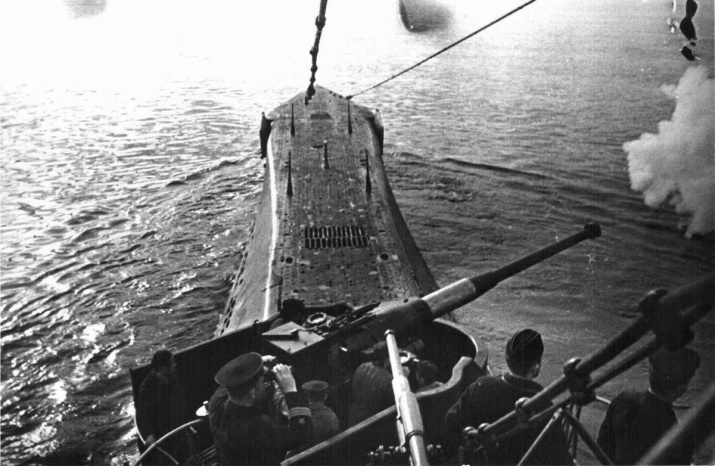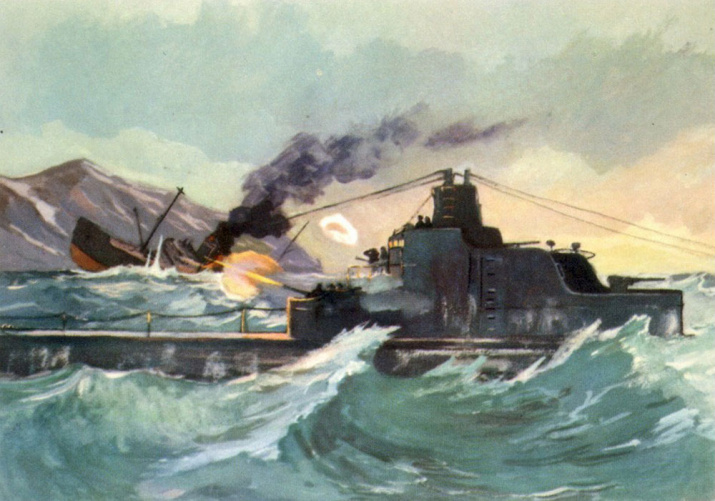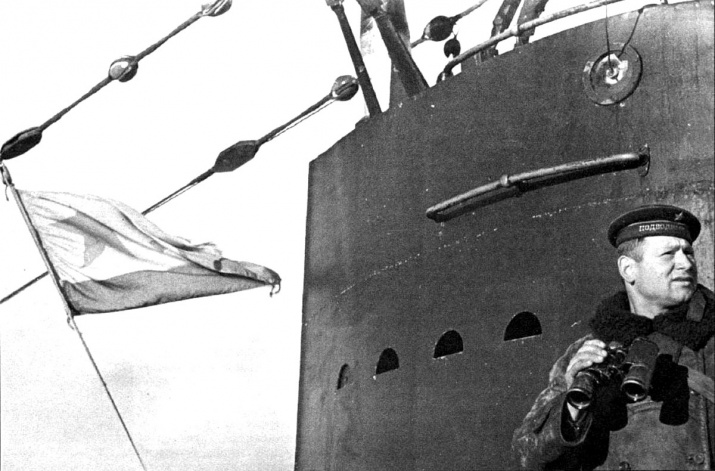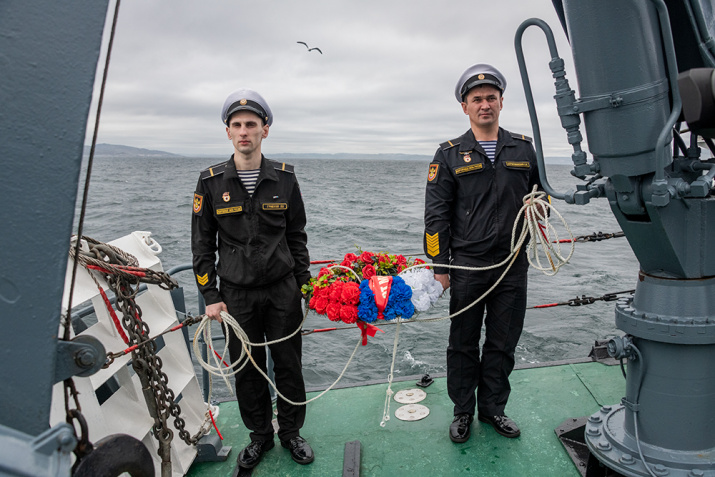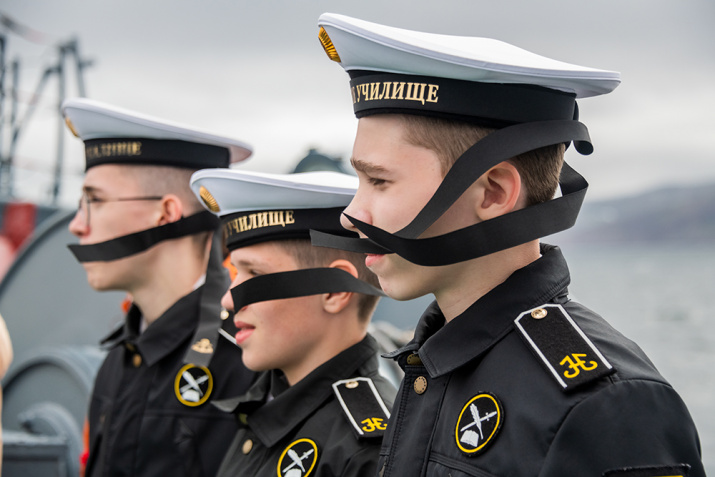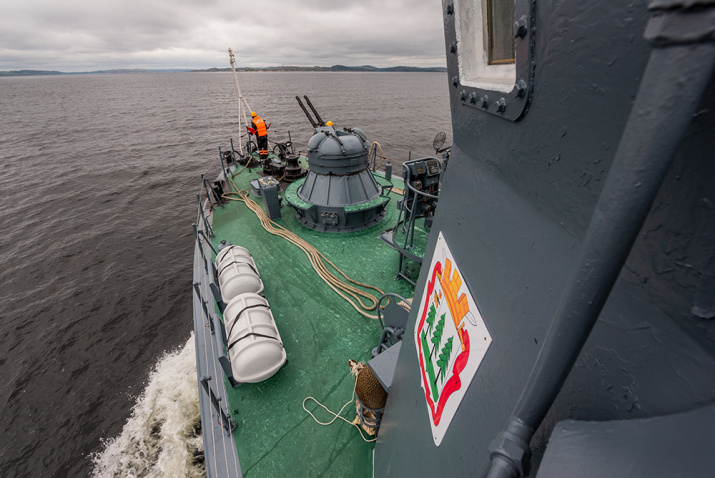K-2 submarine
Historical information
K-2 cruising submarine of the XIV-class
Based on the publications of M. Morozov
(information taken from the sovboat.ru website with corrections and additions)
It was laid down on December 27, 1936 under the slipway number 452 at the plant No. 194 in Leningrad. On April 29, 1938, the submarine was launched, and on December 16, 1939, after carrying out a complex of acceptance tests, it began operating. Vasily Utkin, Captain of the 3rd rank commanded the ship. On May 26, 1940, a ceremony of raising the Naval Flag took place on the ship, and the next day K-2 sailed North along the White Sea-Baltic Canal. On July 7, the vessel arrived in Belomorsk, and on the same day she was enlisted in the 1st Division of the Northern Fleet Submarine Brigade; on July 18, the submarine officially joined the Northern Fleet.
On July 20, during the transition from the White Sea to Polarny, K-2 collided with the destroyer "Karl Liebknecht" accompanying her in the area of Seven Islands. The impact was tangential, but, nevertheless, the hulls of both ships received numerous dents. After emergency repairs, the crew of the submarine began to work out the tasks of combat training, and although in the autumn of 1940 the submarine conducted a complex of tests of a mine device with a training setting of mines, it was not possible to do much, by the beginning of the Great Patriotic War the ship was in the organizational period. K-2 has just completed warranty repairs in Murmansk, and the crew of the submarine was preparing to work out combat training tasks. In addition to this, the submarine commander had a serious illness, it was planned to write him off for a coastal position, and instead appoint a graduate of the Naval Academy, Lieutenant Commander M.A. Bibeev, but soon, according to doctors, V.P. Utkin's health got better and he remained the commander of K-2.
The K-2 went on its first combat campaign only in the morning of August 7, 1941. By this time, the ship's crew hastily passed only the first tasks of the "Course", but did not conduct a single firing; neither with torpedoes nor with artillery. Commander of the 1st submarine division, captain of the 2nd rank M.I. Gadzhiyev was in charge of the actions which were to take place in the area of Tana Fjord - Bos Fjord (position No. 4). On the evening of August 8, a submarine in an underwater position entered the Tana Fjord, but there was no one there. The next evening, K-2 met a tanker of about 3,000 tons, going unguarded. The commander of the submarine decided to attack the tanker with torpedoes, but the ship turned and went behind the breakwater into Berlevog Bay, and as soon as the submarine moved away from the shore, it went out to sea again. This time, not wanting to miss the target, the submarine commander ordered the tanker to be shot with artillery. From a distance of about 4 miles, K-2 opened fire from the bow 100-mm gun, having managed to make eight shots before the ship disappeared behind the islands in Kongs Fjord, but did not reach the tanker.
The next encounter with the enemy took place on the evening of August 10, when K-2 discovered two vessels under the protection of a pair of patrol boats heading for Kirkenes. Trying to take a favorable position for the attack, the submarine overtook the caravan in a surface position, but was discovered and fired at by the escort ship on the way. However, this did not prevent K-2 from attacking. From a distance of 4 cable lengths, the submarine fired two torpedoes from the stern tubes at one of the transports, but there were no explosions. On K-2, the lack of the surprise element was considered the reason for the unsuccessful attack. A similar situation happened a day later, when, while trying to overtake the convoy in a surface position, K-2 was detected by a destroyer (in reality it was the Bremse training ship), which went for a rendezvous. The submarine had to go underwater urgently, and the attack failed.
The day of August 13 was full of combat episodes. In the morning, in the area of Tana Fjord, the submarine met the transport, accompanied by a guard. Due to the mistakes of the steering group, the submarine could not keep the desired depth. The periscope was in and out of the water, as a result, it was noticed and fired at. The submarine still fired at the ship with two torpedoes, but they missed the target. A few hours later, K-2 found a pair of German destroyers (probably Z-7 and Z-20), but could not attack them due to the long distance to the target, and in the afternoon the submarine met a trawler (one of the German fishing trawlers). From a distance of 7 cable lengths, the submarine fired a torpedo at the trawler, which passed 5-7 m from the stem. Since the submarine's periscope was detected from the ship, they preferred to turn to the coastline. Surfacing, the submarine tried to destroy it with artillery fire, but none of the 15 100-mm shells fired by K-2 hit the target, and the trawler, having dropped the catch, meanwhile went under the shore at full speed.
Further patrolling also did not bring success. Twice (on August 16 and 19), K-2 detected enemy convoys, but since the submarine was far from the shore, it could not catch up with them; the old battery of the submarine (operating since March 1939) was discharged, there was not enough electrolyte density. An attempt to launch torpedoes at a single destroyer (in fact, the Bremse training ship) on the evening of August 20 ended with the discovery of a submarine and a counterattack, during which the enemy unsuccessfully dropped 10 depth charges on the submarine.
In addition to this, on August 15, some problems occured with the bow horizontal rudders due to rusted ballers. On the night of August 30, K-2 began returning to base, and on the morning of the 31st arrived in Polyarny.
By this time, squadron mines intended for Katyusha vessels had arrived in the North (by the beginning of the war, the fleet had only six practical and 16 combat mines of this type for underwater minelayers, and, in the latter, the condition of hydrostatic boxes and powder retarders excluded their combat use). Since in the next combat campaign K-2 had to be the first of the submarines of the Northern Fleet to create a minefield off the enemy coast, and, given that the previous patrol of the submarine was unsuccessful, Commander Gadzhiyev went to sea again on board of the submarine.
On September 7, the submarine left Polyarny. This time she had to operate in the area northwest of Vardø (position No. 5). On the morning of September 10, she successfully laid mines of barrier No. 14 between Cape Kibergnes and the island of Vardø. They were placed in a difficult area of shallow water from an underwater position. K-2 risked running aground, thereby revealing herself. Unfortunately, due to the failure of the mine device (incorrectly adjusted drop levers did not return to their original position, and they had to be turned manually), only three units of four mines were put. The last, 13th mine was dropped using a manual drive 600 m from the third unit, and seven mines returned back to the base. Fortunately for the Germans, the mines were put away from the navigable fairway. They were discovered during a control trawling by the 3rd trawler flotilla on November 8 and destroyed in November-December.
After laying mines, K-2 shifted along the coast to the west. On the afternoon of September 12, at Cape Harbaken, the submarine met the Norwegian cargo and passenger steamer Lofoten (1571 grt), which carried out coastal transportation on the Bergen – Kirkenes line. The submarine could not take a position for a torpedo attack, so it was decided to attack the ship with artillery. Surfacing, K-2 opened fire from the bow gun. Gunners under the command of Lieutenant Z. M. Arvanov fired 26 100-mm shells from a distance of 40-45 cable lengths in 7 minutes. From the submarine, they watched as the target, having received several hits, turned to the shore. The shelling was interrupted by an Ar-196 seaplane. The submarine was forced to go underwater urgently, and did it on time, as soon two depth charge explosions were noted on the submarine. Half an hour later, surfacing under the periscope, the submariners no longer found the ship, which managed to hide behind one of the islands. Nevertheless, the transport was considered sunk.
P. K. Stepushkin (1914 - after 1985). Participant of five combat campaigns on K-2 and battles on land. In May 1942, he was wounded, since mid-1943, he was the commander of the steering department on the SHCH-404, petty officer 1st class
On the afternoon of September 18, K-2 returned safely to Polyarny. At the entrance to the Ekaterininskaya Harbor, the submarine fired one blank shot from the gun, which later became a tradition for Severomorsk submariners returning from a successful combat campaign, when the returning submarine fired as many blank volleys as enemy ships, according to submariners, were sunk.
By autumn, the condition of the K-2 battery was close to critical. She had already worked out the required charge-discharge cycles, her capacity was only enough for about 10 hours of small underwater travel, and when trying to stay at periscope depth, the batteries discharged even faster. There was nowhere to take a new battery; there was no spare, and the Leningrad plant named after Lieutenant Schmidt, which produced these products, was under blockade.
Nevertheless, K-2 went on two more combat campaigns. In mid-October, the submarine was located north of Hammerfest (position No. 2a), where it operated from October 13 to 23, but due to the condition of the batteries, it did not make any attempts to enter the skerry area. Upon returning to the base, K-2 got into a 7-point storm and was covered by a wave. 40 tons of water that got through the open deckhouse and air supply shafts to the diesels flooded the main rowing electric motors, a low-pressure compressor, blowers, motors for dropping mines and a commander's periscope motor, as well as six battery tanks.
The next patrol, which took place in the second half of November in the area of Cape Nordkin - Tana Fjord (position No. 4), also failed. On November 21, K-2 encountered an enemy patrol boat, but did not attack it, dodging by going underwater. At the end of the patrol (from November 22 to November 25), the submarine, by order of the command, shifted to the north so as not to interfere with the joint Soviet-British operation to bombard Vardø.
Returning to the base, K-2 got up for repairs at the Sevmorput plant in Rostov. On February 6, 1942, during the repairs, an explosion occurred, resulting in the death of a Red Navy officer V.S. Samoletov who worked in the hold. In early March, the long-awaited battery arrived, and on March 27, K-2 began operating.
The 1942 K-2 campaign began on the morning of April 9. The day before, the submarine SHCH-421, while in position, hit a mine in Laks Fjord and lost its course. To help the submarine, K-2 was sent, on board of which was the commander of the 1st submarine division, Captain 2nd rank M.I. Gadzhiyev, but already at 17.00 the submarine was ordered to return to the base, since by that time the crew of the emergency submarine had been taken on board by K-22 operating nearby, and the SHCH-421 itself was sunk due to the impossibility of towing.
Returning to Polyarny, K-2 stayed there for a little more than a day, and in the evening of April 11, she headed northwest of the Vardø - Tana Fjord (positions No. 5 and No. 4). In the evening of April 15 the submarine laid mines north of Vardø (barrier No. 40). This time the mine device worked flawlessly. Unfortunately, two days later, the motor trawlers R-55, R-90 and R-91 from the 5th Flotilla, conducting a control trawling of the fairway, discovered a minefield, and by April 21 it was cleared. Considered as victims of the K-2 mines, the German transport Akka (2646 grt), which was blown up and washed ashore on November 29, 1942 in the Vadsø area (square AC 8476), probably suffered damage as a result of an explosion on a floating mine, of which there were many in that area at that time. After the submarine was freed from mines, it shifted northwest, to the Kongs Fjord. There was no shortage of goals. On the morning of April 22 and evening of April 26, K-2 was unable to attack as the target's angle on the bow was rather big, and on the afternoon of April 22, when meeting an enemy convoy, before K-2 could take up an attack position, she was driven away by the Uj-1104 submarine chaser, which discovered the submarine's periscope and dropped eight depth charges at a safe distance from the submarine.
On the evening of May 2, at Cape Kjelnes, K-2 attacked a convoy vessel with four torpedoes from a distance of 14-15 cable lengths. At the moment of the salvo, the submarine did not hold the depth, and, discovered by the escort ships, was subjected to a short but fierce pursuit just at the moment when she was going to observe the result of launching torpedoes that passed astern of the transport "Iris" (1177 grt). After the submarine chasers Uj-1106, Uj-1111 and the patrol ship V-6108 found the submarine's cabin emerging from the water, they dropped 56 depth charges on it. Fortunately for the submariners, the escort ships could not establish sonar contact with the target, but even those 9 minutes of bombing were enough. On the K-2, the welds of the light hull and deck flooring cracked, the motor of the bow horizontal rudders was jammed, water got into the air supply shaft to the diesels. In addition, after the end of the combat alarm, due to an error of the submarine's personnel, an unauthorized launch of a torpedo from the apparatus No. 5 occurred. Nevertheless, the attacked vessel was considered sunk. The submarine went to the base, she arrived there on the afternoon of May 4.
After carrying out a small repair, on the morning of June 26, the submarine goes to sea again. This time, the purpose of the K-2 campaign was to protect the Allied convoys QP-13 and PQ-17. The submarine operated in the so-called "Lopp Sea" - a segment on the western section of the German communication between the islands of Sere, Lopp and Fugle (position No. 2). On the afternoon of June 29, K-2 found an armed motorboat, but in order to maintain secrecy, she did not attack it and avoided diving, and on the morning of July 1 she was attacked by an enemy aircraft that fired cannon and machine gun fire at the submarine, as a result of which K-2 received minor damage (in two places the bow superstructure was pierced by bullets), but remained in position, from which she was recalled to the base only on the night of July 16.
On her last combat campaign for operations in the Tana Fjord area, K-2 left on the night of August 26, 1942. On the night of September 7, according to the plan to cover convoy PQ-18, the submarine was ordered to change position, but no conditional signal was received about the submarine moving to another area (it was supposed to follow on the morning of September 9). Further attempts to establish communication with the submarine and its search by aircraft led to nothing.
Prior to the discovery of K-2, it was believed that she died on one of the Karin or Sperre-III mines in the Tana Fjord area in early September 1942 or on the Bantos-A minefield north of the Rybachy Peninsula while still en route to the position.
Found in the Bantos-A minefield.
There were 68 people on board the K-2 in the last campaign.
Eight combat campaigns:
07.08.1941 – 31.08.1941
07.09.1941 – 18.09.1941
11.10.1941 – 24.10.1941
13.11.1941 – 02.12.1941
09.04.1942 – 10.04.1942
11.04.1942 – 04.05.1942
26.06.1942 – 17.07.1942
26.08.1942
There are no confirmed victories.
Giving military honors to sailors
who died on the submarine K-2 and the big submarine chaser BO-224
From the press release of the Ministry of Defense:
Today, the crew of the base trawlers "Yelnya" of the Kola Flotilla of the heterogeneous forces of the Northern Fleet, together with representatives of the Russian Geographical Society, laid wreaths and flowers on the water of the Barents Sea at the places of death of the big submarine chaser BO-224 and the cruising submarine of the Northern Fleet K-2.
Commemorative events in the Barents Sea took place on the eve of the 80th anniversary of the beginning of the Great Patriotic War in this area for the first time. In addition to the servicemen of the Kola Flotilla of diverse forces and members of the Russian Geographical Society, the events were attended by cadets of the Young Army Cadets National Movement from the city of military glory of the Polarny and from Murmansk, as well as from the Nakhimov Naval School.


